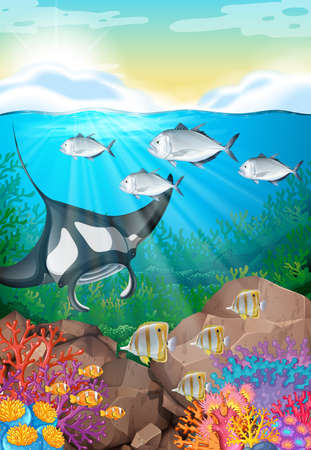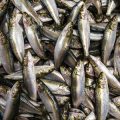1. What is a Thermocline and Why Does it Matter?
If you’ve ever fished a deep water reservoir in the summertime, you might have heard anglers talk about the “thermocline.” But what exactly is a thermocline, and why should you care if you’re trying to locate big bass, walleye, or other game fish?
Understanding the Basics: What is a Thermocline?
In simple terms, a thermocline is a layer in the water where the temperature changes rapidly from warm to cold as you go deeper. Think of it as an invisible wall that separates warmer surface water from much cooler water below. This sharp change usually happens somewhere between 10 and 30 feet down, depending on the lake and time of year.
How Thermoclines Form
During late spring and summer, the sun heats up the top layer of water in a reservoir. Meanwhile, deeper water stays chilly because sunlight can’t reach that far. The result? You get three distinct layers:
| Layer Name | Description |
|---|---|
| Epilimnion | Warm surface layer, well-oxygenated and mixed by wind |
| Thermocline (Metalimnion) | The middle layer where temperature drops quickly with depth |
| Hypolimnion | Cold bottom layer, low oxygen, little mixing |
Why Does the Thermocline Matter for Fishing?
Game fish are just like us—they want comfort! Fish tend to hang out near the thermocline because it’s where they find the best combo of comfy temperatures and enough oxygen. If you drop your bait above the thermocline during hot weather, fish might not be there because it’s too warm. Go too deep below it, and you’ll hit cold water with very little oxygen—another no-go zone for most species.
How Temperature Layers Impact Fish Behavior
- Baitfish Concentration: Smaller fish gather along the thermocline, drawing in predators like bass or walleye.
- Active Feeding Zones: Most feeding activity happens just above or along the thermocline line.
- Limited Depth Range: Fish avoid both super-warm surface water and cold oxygen-poor depths.
Understanding where the thermocline sits in your local reservoir helps you put your lure right in the strike zone—where fish are comfortable and actively feeding.
2. How to Find the Thermocline: Tools and Tactics
Understanding the Thermocline in American Reservoirs
The thermocline is a layer in deep water reservoirs where the temperature changes rapidly with depth. For anglers, locating this layer is key because many game fish like bass, walleye, and trout hang out just above or right on this temperature line—especially during hot summer months. But how do you find the thermocline when you’re out fishing in big American lakes and reservoirs?
High-Tech Tools: Depth Finders and Sonar Units
Most modern anglers rely on electronics to spot the thermocline quickly and accurately. Here’s a look at the most common tools:
| Tool | How It Works | What You’ll See |
|---|---|---|
| Depth Finder (Fish Finder) | Sends sonar waves down into the water and shows a digital image of what’s below your boat. | A faint, hazy line or band that appears at a consistent depth across the screen—this usually marks the thermocline. |
| Advanced Sonar (Down Imaging/Side Imaging) | Gives more detailed images using high-frequency sonar signals. | The thermocline looks like a thin, cloudy strip. Fish often stack just above this line. |
Tips for Using Electronics
- Set sensitivity high enough to pick up subtle lines without adding too much clutter.
- If you see baitfish or game fish grouped along a certain depth, check if that aligns with a visible thermocline layer.
- Some units allow you to adjust color palettes—try different ones to make the thermocline stand out more clearly.
Low-Tech Methods: Finding the Thermocline Without Electronics
If you don’t have fancy gear, don’t worry—you can still locate the thermocline using some tried-and-true tricks:
| Method | How To Do It | What To Look For |
|---|---|---|
| Weighted Thermometer | Tie a thermometer to a line with weights. Lower it slowly, stopping every few feet to read the temperature. | A sudden drop (usually 5°F or more) over just a few feet means you’ve hit the thermocline. |
| Bait Behavior | Watch where baitfish are holding or where birds are diving. | Baitfish often suspend just above the thermocline; game fish follow their food source. |
| Lure Drop Test | Drop your lure and count how long it takes to reach different depths. Sometimes you’ll feel a difference in resistance as it passes through water layers. | A change in how your lure moves or feels can clue you in to denser, colder water—the thermocline zone. |
Why Knowing the Thermocline Matters for U.S. Anglers
Finding this “magic layer” can make or break your day on the water. In most American reservoirs, especially during summer, game fish stick close to the thermocline because that’s where oxygen levels and temperatures are just right. By using depth finders, sonar, or simple thermometer tests, anglers get dialed in on where to place their baits for better success—and maybe even land that trophy catch.
![]()
3. Seasonal Changes and Thermocline Formation
Thermoclines don’t stay in the same place all year—they form, shift, and even disappear as water temperatures change with the seasons. Understanding when and how these changes happen is key if you want to consistently find game fish in deep water reservoirs across the U.S.
How Thermoclines Develop Throughout the Year
In most American reservoirs, thermoclines start forming in late spring as the sun warms the upper layers of water faster than the deeper layers. By early summer, a noticeable temperature difference develops between these layers, creating a well-defined thermocline. Game fish like bass, walleye, and lake trout often hang out right above or along this “temperature wall,” where food is abundant and oxygen levels are comfortable.
Seasonal Thermocline Patterns
| Season | Thermocline Behavior | What it Means for Fishing |
|---|---|---|
| Spring | No thermocline—water mixes evenly | Fish can be found at various depths; focus on shallow waters warming up first |
| Early Summer | Thermocline starts forming 10-20 feet down (depending on lake) | Game fish stack up just above or at the thermocline |
| Midsummer | Strong, stable thermocline, usually 15-30 feet deep | This is prime time—target fish right at the thermocline’s edge |
| Late Summer/Early Fall | Thermocline begins to drop deeper or weaken as surface cools | Fish may follow it deeper or scatter as water mixes again |
| Fall Turnover | Thermocline disappears—water mixes top to bottom | Baitfish and predators spread out; fishing becomes less predictable for a while |
Why Timing Matters for Anglers
If you’re fishing too early or too late in the season, you might miss out on those periods when game fish are tightly grouped near the thermocline. As water temperatures rise and fall, baitfish move—and so do their predators. Knowing when your local reservoir’s thermocline forms can give you a serious edge: you’ll spend more time fishing where the action is and less time guessing. Local fishing reports or a good fishfinder with temperature sensors can help pinpoint these changes week by week.
4. Targeting Game Fish Around the Thermocline
Popular U.S. Sport Fish and the Thermocline
Many of the most sought-after game fish in American reservoirs are strongly influenced by the thermocline, especially during the warm months. The thermocline acts like a comfort zone, offering cooler water and higher oxygen levels. Here’s how some popular species relate to this unique layer:
| Species | Relationship to Thermocline | Prime Season |
|---|---|---|
| Largemouth Bass | Often suspend just above or right at the thermocline to stay cool and find baitfish. | Late spring through early fall |
| Smallmouth Bass | Prefer areas near rocky points or drop-offs close to the thermocline. | Summer |
| Walleye | Frequently found cruising along the thermocline, especially at dawn and dusk. | Summer to early fall |
| Striped Bass | Follow schools of baitfish that gather around the thermocline. | Mid-summer through early fall |
| Crumble (Crappie) | Suspend in large schools near or just above the thermocline. | Late spring through summer |
How to Present Baits and Lures at the Right Depth
If you want consistent success fishing deep-water reservoirs, it’s important to get your bait or lure right into that thermocline zone where fish are comfortable and feeding. Here are some easy strategies:
1. Use Electronics for Precision
A quality fish finder or sonar unit will help you locate the depth of the thermocline and spot suspended fish. Set your electronics to show temperature changes and look for bands of baitfish stacked up—these usually hang right at or above the thermocline.
2. Choose Properly Weighted Rigs
If you’re fishing with live bait, use slip sinker rigs or drop-shot setups so you can easily adjust your presentation depth until you’re right on top of the action.
3. Try Vertical Jigging Techniques
This is a classic way to target fish holding steady around the thermocline. Drop your jig or spoon down to just above where you see fish on your sonar, then work it slowly for best results.
4. Trolling with Downriggers or Lead-Core Line
Trolling allows you to cover more water at specific depths. Downriggers or lead-core line make it simple to keep your lures running consistently along the thermocline, where predatory fish cruise for food.
Bait & Lure Suggestions by Species
| Species | Bait/Lure Type | Tactic |
|---|---|---|
| Largemouth Bass | Soft plastics, deep-diving crankbaits | Casting near drop-offs; slow retrieve at thermocline depth |
| Walleye | Nitecrawlers on harnesses, jigging spoons | Trolling or vertical jigging along thermocline breaks |
| Striped Bass | Spoons, swimbaits, live shad | Trolling with downriggers or live-lining above thermocline schools |
| Crappie (Crumble) | Minnows, small jigs under slip bobbers | Suspend bait just above thermocline; watch sonar for schooling fish |
| Smallmouth Bass | Tubes, blade baits, finesse worms | Dropshotting near rocky structure at correct depth range |
The key is to match your technique and presentation depth to where the fish are concentrated—right around that magic layer called the thermocline. By focusing your efforts here, you’ll increase your chances of hooking up with trophy-sized game fish all season long.
5. Tips for Fishing Deep Water Reservoirs Like a Pro
Choosing the Right Gear for Thermocline Fishing
Fishing the thermocline in deep reservoirs means your setup has to handle both depth and finesse. Here’s what you need:
| Gear | Recommended Choice | Why It Matters |
|---|---|---|
| Rod & Reel | Medium-heavy spinning or baitcasting combo, 7’+ | Allows long casts and enough backbone for bigger fish at depth |
| Main Line | Braided line (20-30 lb test) | Braid cuts through water better and offers sensitivity to feel subtle bites deep down |
| Leader | Fluorocarbon (10-15 lb test) | Virtually invisible in clear reservoir water, crucial for finicky fish |
| Lures/Baits | Spoons, drop shot rigs, deep-diving crankbaits, live bait rigs | Mimics natural prey at the thermocline zone; gets down fast and stays in the strike zone longer |
| Electronics | Fish finder/sonar with temperature gauge | Pinpoints the thermocline depth and identifies schools of game fish |
Safety Considerations for Deep Water Reservoirs
- Wear Your Life Jacket: Deep water can be dangerous even for strong swimmers. Always wear a U.S. Coast Guard-approved PFD.
- Check Weather Conditions: Thunderstorms and high winds can come out of nowhere on big reservoirs—check the forecast before heading out.
- Tether Gear: Use lanyards or floats for pliers, phones, and electronics—deep water means lost gear is gone for good.
- Avoid Overloading: Keep your boat balanced and avoid carrying more than its rated capacity, especially when moving around searching for fish.
- Stay Hydrated and Protected: Sun exposure is no joke on open water—bring plenty of water, sunscreen, and a wide-brim hat.
Maximizing Bites Around the Thermocline
Find the Right Depth Fast:
Your fish finder is your best friend here. Look for that sharp temperature break—the thermocline—usually between 15-35 feet depending on the season. Game fish like bass, walleye, and stripers often stack up just above or along this layer because it has the right mix of oxygen and forage.
Presentation Matters:
- Suspend Your Bait: Use slip bobbers or vertical jigging to keep your lure right at the thermocline level. Don’t fish too far above or below it—fish hang tight to this comfort zone.
- Mimic Local Forage: Match your lure size and color to shad, herring, or perch common in your reservoir. Natural movement gets more strikes.
- Scent Can Help: Adding scent attractants or using live bait can trigger bites from neutral or inactive fish hugging the thermocline.
Time Your Trip:
Dawn and dusk are prime times as game fish move up from deeper water to hunt along the thermocline edge. Cloudy days can extend these feeding windows, so keep fishing even if the sun disappears.
Pro Tip:
If bites slow down, tweak your lure speed or switch colors. Sometimes all it takes is a little change to fire up those suspended fish!


